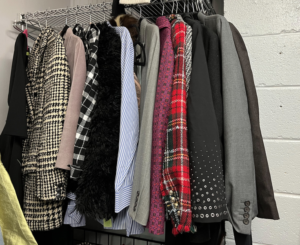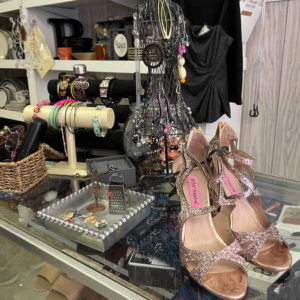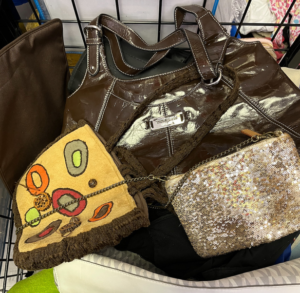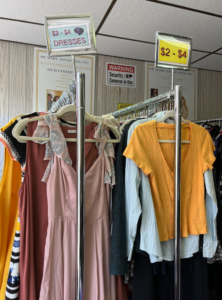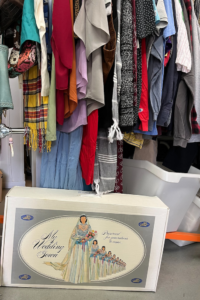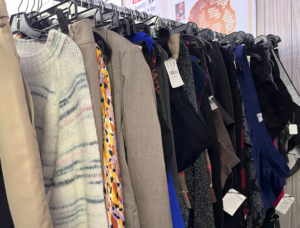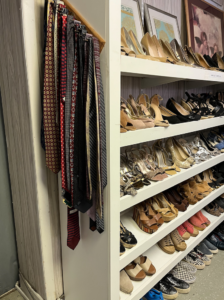
HOBOKEN, NJ — Alexander McQueen. Diane von Furstenberg. Calvin Klein. Louis Vuitton. Betsy Johnson.
These are some of the name-brand and designer labels you’ll find tucked away at the St. Mary Advocates Thrift Store in Hoboken.
In fact, the Garden Street shop has an aptly named “Wow” rack, where, on any given day, there’s a host of gems to discover, many of which still have the tags on them and have never been worn.
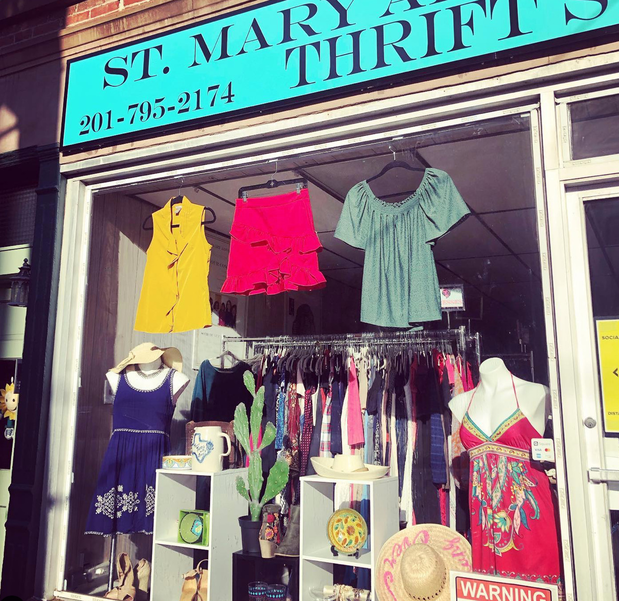
Buying used clothing supports environmental sustainability. Photo credit: Kimberly Redmond
Billed as “not your grandmother’s secondhand store”, St. Mary Advocates offers clothing and accessories for women, men and children, along with toys, household items and other various treasures at a much cheaper price than buying new from retail or line.
How about a J.Crew men’s dress shirt for $1? Or a pair of Lululemon pants for $3? Or maybe a Tiffany & Co. charm bracelet for $100? Interested in a Canada Goose parka for $50?
“We’re only as good as our donations,” said Sarah Bond, who has volunteered at the shop for the past four and a half years.
In that case, St. Mary Advocates is doing phenomenally.
In a city like Hoboken, with its thriving community of young professionals, closet space is limited. So, the thrift shop regularly winds up with donations of high-end items when residents purge wardrobes to make way for new items.
“We are a little unique because we’re Hoboken, so a lot of our labels are a little more high-end and we sell them at very reasonable prices,” Bond explained.
Once regarded as a place for low-income shoppers only, secondhand stores have found a fresh wave of popularity thanks to a growing desire among younger generations to shop responsibly and sustainably.
“The under-40 population loves to do things with a purpose,” Bond said. “Shopping here, there’s a purpose because the money is going somewhere.”
By 2026, the value of the U.S. secondhand apparel market is expected to more than double to reach $82 billion, a trend driven by younger shoppers, a newly released analysis from resale platform thredUP found.
- 41% of consumers look first for secondhand apparel when they’re shopping, including 62% of Gen Z and Millennials
- Secondhand purchases displaced nearly one billion new clothing purchases last year
- Nearly two out of three consumers believe their individual consumption habits have a significant impact on the environment
- 74% of consumers say secondhand apparel is more socially acceptable now than it was five years ago and 72% of thrifters are proud to tell others that their outfit is secondhand
Besides being eco-friendly, embracing pre-owned clothing gives shoppers an opportunity to stretch their dollar further during a time of inflation, according to thredUP.
Fifty-eight percent of consumers say buying secondhand has been a huge help, while 25% said they’ll consider purchasing more thrifted apparel if prices keep rising.
Depending on where you shop, getting thrifty provides the ability to support a good cause.
Founded by Lucille Casulli in 1976, St. Mary Advocates Thrift Store is a non-profit, volunteer-run organization that donates 100% of its proceeds right back into the community. Just a few of those beneficiaries include the Hoboken Shelter and the Hoboken Volunteer Ambulance, as well as scholarships related to healthcare and health education.
Despite being closed for seven months due to the COVID-19 pandemic, the thrift store generated over $36,000 for donations to charities and scholarships in 2019-2020 — a testament to the community’s support for what St. Mary Advocates is doing.
“A lot of people shop here because we’re doing something they like; they’re not necessarily here because they can’t afford [buying new]. Maybe for the college kids, it’s a great way to spread their budget a little thicker, but most people like that we give money back locally,” Bond said.
“People are also very proud to donate stuff. They’re usually like ‘I love this, but I don’t need it anymore and you guys are doing such a great job,’” she said.
On the flip side, St. Mary Advocates volunteers also “see a lot of people who find stuff they used to have as a child or that someone in their family used to have,” Bond added. “It is memorable when you see someone really connect with an item.”
While the store receives millions of pounds of donations every year, not every item makes it to the shelf, unfortunately.
But, the shop estimates it keeps “thousands upon thousands of unwanted, unsellable merchandise [items] out of landfills.”
For articles with rips, stains, pulls or broken zippers, the store encourages people to drop those items into clothing donation bins typically found in parking lots or gas stations. For apparel items in good condition that do not sell, the store hands those over to GreenDrop, a service that recycles and repurposes lightly used clothing into critical funds for charities.
And, for items that are in mostly decent shape, but may have a small imperfection, St. Mary Advocates will give them to the local homeless shelter, Bond said.
Its efforts have not gone unnoticed. St. Mary’s Advocates Thrift Store has been certified as a sustainable business by the City of Hoboken, as well as the New Jersey Sustainable Business Registry.
And although thrift stores play a solid role in diverting items otherwise destined for the garbage heap, they are struggling in an era of fast fashion — the cheap, quickly made, trendy clothing that allows consumers to rapidly expand and refresh wardrobes.
Unfortunately, much of the clothing sitting on store shelves is made from materials that can be harmful to people and the environment, industry critics say. Very often, manufacturers will use water that is contaminated with bleaches, solvents, dyes, acids and resin.
Nowadays, the typical shopper purchases 60% more clothing pieces a year than the average person 15 years ago and keeps them for about half as long, according to a report commissioned thrift store chain Savers.
Sustainable fashion is a movement that aims to change the cycle of fashion, beginning with production and consumption and ending with waste. It encourages wearing clothing made in an eco-friendly way, purchasing fewer but better-made pieces of clothing, wearing them more often and making sure garments are eventually recycled.
In doing so, it helps reduce the need for cheap labor for cheap fashion by supporting less fast fashion and more of a circular economy.
There are many ways to shop smarter and curate a closet that is not only environmentally and ethically conscious, but unique, according to Ivana and Marija Curic, twin sisters who have been running their eco-friendly clothing line Curic&Curic out of Hoboken since 2017.
“From our perspective, the best way is to resort to vintage pieces,” they said. “We source vintage denim and make them new again by hand painting new and trendy designs.”
Hitting vintage or thrift stores “is a great way of shopping more sustainably,” the sisters said. “Also, looking out for brands [whose] main goal is sustainability is such a plus, because most of the brands have an earth-conscious reason for it.”
To check out Curic&Curic, click here.
To learn more about how to donate (or volunteer!) at St. Mary Advocates Thrift Store, click here.
This story was co-produced in collaboration with CivicStory and the NJ Sustainability Reporting project.
